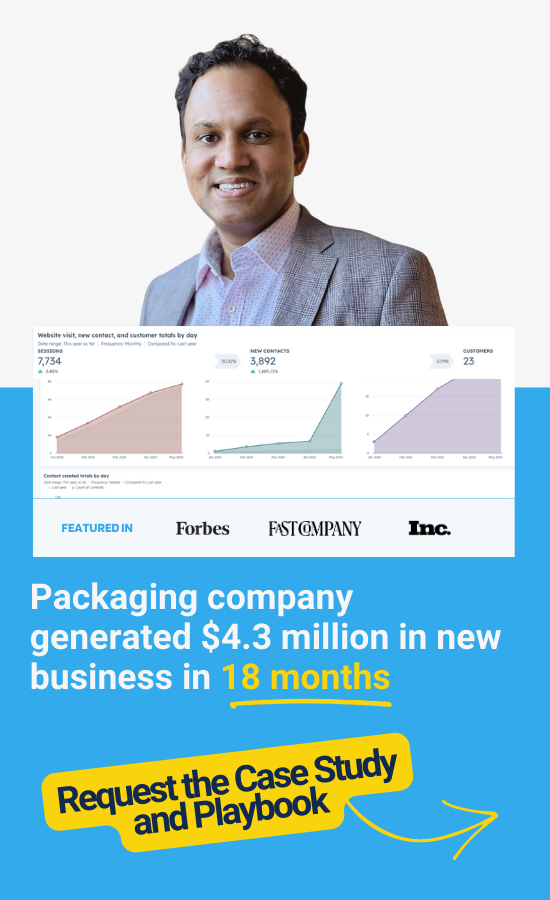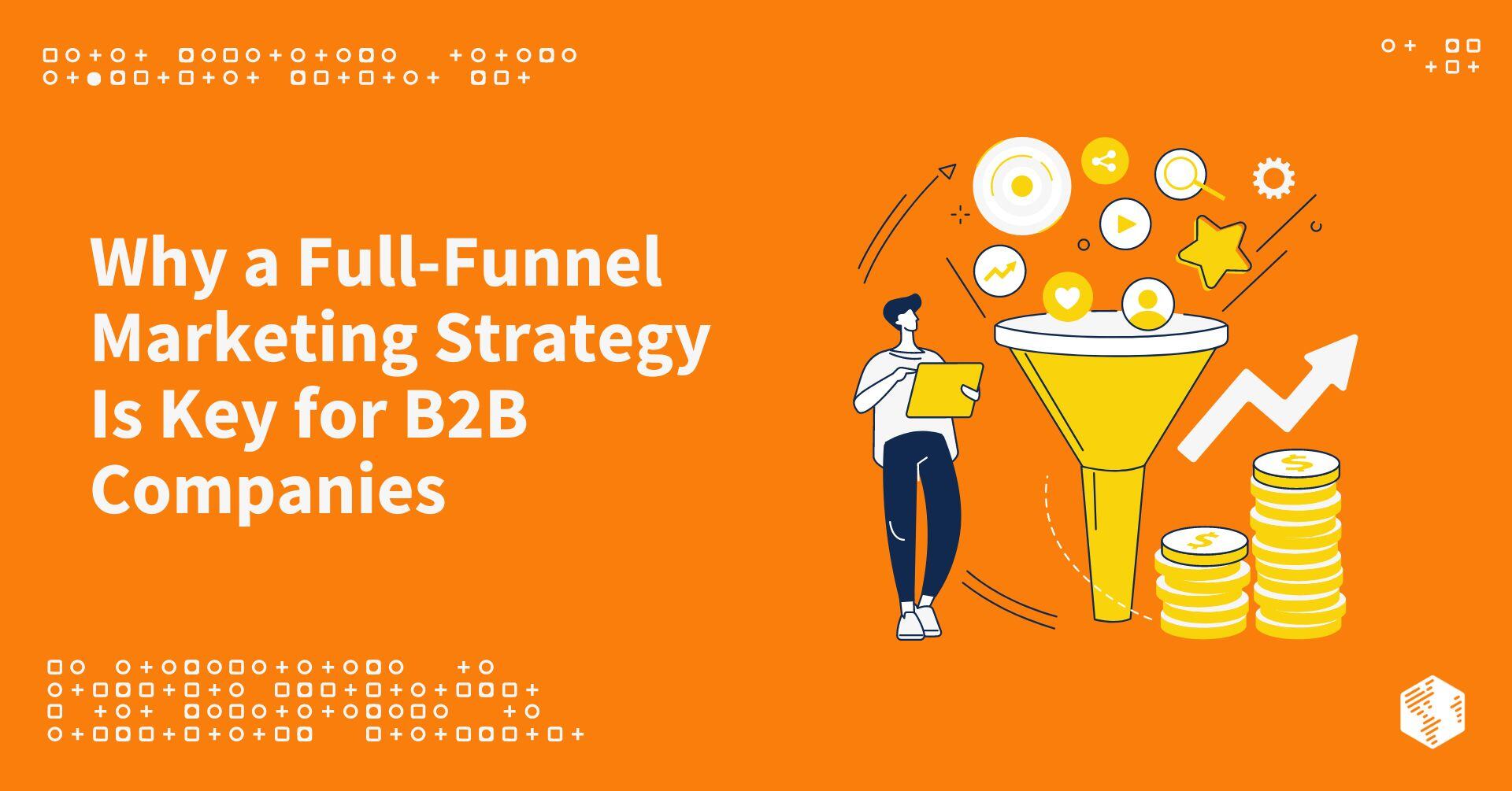Table Of Contents
If your B2B organization is seeking sustainable growth, you need to master full-funnel marketing.
Why? Let’s look at the numbers: Only about 5% of your market segment is ready to make a purchase. That leaves 95% of your target customers up for grabs. But if you’re only marketing to the few businesses that know exactly what they want and are ready to buy it, you’re missing out on a vast untapped market. And vice versa—focusing your efforts and budget on grabbing the attention of that larger group means you aren’t generating business from those most likely to buy.
Fortunately, with a full-funnel marketing strategy in place, you can reach new heights at every stage of the customer journey, from initial awareness to purchase and beyond.
Let’s talk about the power of marketing across the funnel.
What Is a Full-Funnel Strategy in B2B?
At its core, a full-funnel strategy is about meeting your potential customers wherever they are in the buying journey, whether they are just becoming aware of their problem, considering their options, or getting ready to make a purchase. It’s all about being present and relevant when your prospects need you most.
Unlike a linear path, customers often revisit stages as they gather information and weigh their options. Your job is to guide potential customers through the funnel and into your loving arms.
What Is the B2B Marketing Funnel?

The B2B marketing funnel visually represents the customer journey, outlining the steps a potential buyer takes from discovery to becoming a customer and beyond. Understanding these stages allows you to tailor your marketing campaigns and content effectively.
Top of the Funnel (ToFu)
At the top of the funnel, potential customers first learn about your brand and offerings. The primary goal here is to create awareness and attract a broad audience.
The top of the funnel is all about getting noticed. You want to create engaging content that draws people in—think educational blog posts, insightful ebooks, and handy checklists. Generating leads at this stage is crucial, because if you don’t have enough visitors at the top, the rest of the funnel won’t fill out.
When you provide valuable content, you start building trust with your audience. And we all know that trust is the key to turning a curious visitor into a loyal customer. The more people know, like, and trust you, the easier it is to grow your business.
Middle of Funnel (MoFu)
When they reach the middle of the funnel, leads have shown interest and are evaluating their options. Now that you’ve got their attention, it’s time to guide your prospects as they weigh their options. The focus shifts to nurturing them with educational content that helps them make informed decisions.
This is where comparison guides, informative videos, and detailed product descriptions come into play. You want to make it super easy for leads to see why your products or services are the right choice.
By understanding your customer’s journey, you can anticipate their needs and deliver the right information at the right time, which not only makes their decision-making process smoother but also helps lower your cost of customer acquisition (CAC). Win-win.
Bottom of Funnel (BoFu)
At the bottom of the funnel, leads are ready to convert into paying customers. Your goal here is to persuade these qualified leads to take action through targeted messaging and incentives.
As your prospects near the finish line, it’s your chance to really shine. Use compelling content to reinforce your unique value. Show them what sets you apart from the competition.
If you’re only doing bits and pieces here, you’re likely leaving money on the table.
Dig a Little Deeper: The Building Blocks of Full-Funnel Marketing
We’ve covered the basics, but now let’s explore each part of the funnel in detail. Here, we’ll go over the types of content you should create, effective strategies to implement, and key metrics to track along the way.
Sure! Here’s a revised version that integrates the content into a more narrative format while retaining the key metrics in bullet points:
ToFu
At the top of the funnel, the goal is to spread awareness of your brand and attract prospects. This stage is all about laying the groundwork for future engagement, with the main goals being to maximize reach and visibility while drawing in qualified leads who are genuinely interested in your offerings.
To achieve these objectives, start by crafting educational blog posts that tackle common industry challenges. Infographics can visually convey important data, while short, engaging videos are perfect for catching attention on social media. Use platforms like LinkedIn, Twitter/X, and Facebook to share your content and grow brand awareness. Hosting webinars and events can showcase your expertise and foster deeper connections with your audience.
Additionally, ensure your content is optimized for search engines to help potential leads discover you, and consider using pay-per-click (PPC) campaigns to target specific keywords directly.
To measure the success of your ToFu efforts, keep an eye on the following metrics:
- Website traffic: Monitor how many visitors come to your website
- Bounce rate: Check for a high bounce rate, which could indicate your landing pages need to be more engaging
- Leads generated: Track the number of leads captured to assess the success of your awareness initiatives
MoFu
In the middle of the funnel, you have leads who are engaged but need nurturing to help them move closer to a decision. This part of the funnel focuses on building trust and demonstrating the value of your products or services.
Personalized content is essential here. Create tailored resources, such as case studies that highlight how your solutions have benefited similar clients, and in-depth white papers that provide valuable insights. Live product demos can significantly enhance engagement, while targeted email campaigns deliver valuable content directly to your leads to keep them informed.
Implementing lead scoring helps you prioritize follow-up actions based on how ready your leads are to convert. And retargeting ads can keep your brand fresh in the minds of leads who have interacted with your content but haven’t yet made a move.
To gauge the effectiveness of your MoFu strategies, consider tracking these metrics:
- Lead engagement: Monitor open rates, click-through rates, and the time leads spend on your website
- Conversion rate: Keep an eye on the percentage of leads that progress to the bottom of the funnel
- Lead quality: Assess the demographics and behaviors of your leads to ensure you’re focusing on the right prospects
BoFu
This is where the magic happens!
Leads at the bottom of the funnel are ready to make a purchase decision, and your goal is to convert them into paying customers while addressing any last-minute concerns.
At this stage, develop targeted content that addresses final objections and highlights your unique value proposition. Consider using product comparison charts and customer testimonials to build credibility. Offering free trials or demos can help leads feel confident in their decision. Incentives like limited time offers or discounts can encourage prospects to finalize their purchase. Personalized follow-ups that address specific needs and questions can further enhance engagement.
Also, retargeting campaigns can re-engage leads who visited your pricing page but didn’t convert, using tailored messaging to prompt action.
To measure your success in the BoFu stage, focus on these key metrics:
- Sales revenue: Track the total sales generated from leads that converted
- Average order value: Understand purchasing behaviors and identify upsell opportunities
- Customer lifetime value (CLV or LTV): Assess the long-term value of your customers to inform retention strategies
6 Benefits of a Full-Funnel Approach
So, what’s in it for you?
Implementing a full-funnel strategy comes with a ton of perks for B2B businesses. Here are a few benefits you can expect from a robust full-funnel marketing strategy.
1. Deep Understanding of Your Audience
By mapping out your customers’ journeys, you can create tailored content that meets their specific needs.
2. Boosted Brand Awareness
The more recognizable your brand, the more trust you build. This boost in brand awareness and recognition leads to faster conversions and increased customer loyalty.
3. Stronger SEO
A content-rich funnel drives organic traffic to your website, reducing the need for costly paid ads and giving you more opportunities for link building.
4. Increased ROI
Focusing on long-term relationships opens the door to sustainable revenue, allowing you to use customer data for personalized marketing campaigns.
5. Nurtured Relationships
With access to your prospects’ contact information, you can stay connected through email campaigns, sharing helpful content, case studies, and exclusive offers.
6. Easy Performance Measurement
The full-funnel approach allows you to track key metrics, helping you adapt your strategy and improve conversion rates.
Why Your B2B Company Should Embrace Full-Funnel Marketing
Adopting a full-funnel marketing strategy isn’t just smart; it’s essential for thriving in today’s competitive B2B landscape. It helps you nurture leads, optimize your marketing efforts, and build lasting customer relationships. And since B2B buying decisions are complex, being present at every stage of the funnel can make all the difference.
By investing time into creating a cohesive full-funnel approach and aligning your marketing efforts with the buyer’s journey, you’ll attract more leads, convert more prospects into loyal customers, and set your business up for sustainable growth and long-term success.
The OneIMS Growth Formula: Your Guide to a Full-Funnel B2B Marketing Strategy
To navigate the complexities of the full-funnel and ensure sustained growth, we developed our proven growth formula framework. This formula serves as a roadmap to help B2B organizations acquire and retain customers effectively while scaling their operations:

By applying this framework, businesses can implement strategies that drive growth more efficiently and effectively.
Acquisition: Capture Demand & Create Awareness
The first half of the growth formula focuses on capturing the existing demand for your products or services and converting active buyers into customers. Strategies might include targeted content marketing, SEO optimization, and proactive outreach to identify and engage potential leads.
Equally important is to create awareness. Increasing visibility and credibility in your target market is essential for generating interest in your products or services. This process could involve engaging content, social media outreach, public relations, or attending industry events to make your brand known to prospective customers.
Retention: Manage & Nurture Leads & Customers
Once you’ve captured leads, the next step is to manage and nurture them effectively—such as guiding leads through the funnel using personalized content, email marketing, and lead scoring to ensure that they have the information they need to make a decision.
Retention is just as important as acquisition. This part of the growth formula focuses on managing existing customers to increase their loyalty, satisfaction, and lifetime value. Personalized customer support, loyalty programs, and regular engagement through newsletters or product updates are all essential to managing and nurturing existing customers.
Conclusion
Implementing a full-funnel marketing strategy is vital for B2B success. By recognizing and addressing the distinct stages of the marketing funnel—ToFu, MoFu, and BoFu—you can create a more effective, cohesive approach that not only drives conversions but also builds lasting relationships with your customers.
At OneIMS, we designed the growth formula framework to support your growth goals. With our proven formula, your business will acquire new buyers, retain existing customers, optimize revenue, and focus on sustainable growth across the entire customer journey.
Ready to learn more? Let OneIMS be your growth partner. Schedule a consultation with us today to get started.






